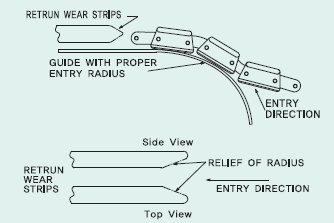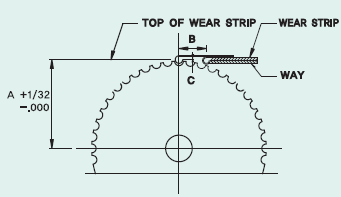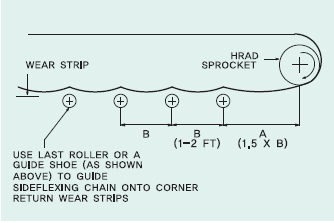|
|
 |
 |
Untitled Document
| 이미지를 클릭 하시면 해당제품을 보실 수 있습니다. |
|
 |
 |
| 컨베이어 관리
1 |
|
 |
| 컨베이어 관리
2 |
|
 |
| 컨베이어 관리
3 |
|
|
 |
|
 |
| |
CATENARY SANG
(CHAIN TENSION CONTROL)
CATENARY SAG (CHAIN 텐션 조절) |
모든 Table Top 체인 컨베이어는 구동기어 치형에 의해 흡수되지 않는 체인
장력의 균형을 맞추기 위한 적당한 양의 쳐짐을 주어야 한다. Table Top 체인은 너무 팽팽하게 당겨서도
안되며 CHAIN 쳐짐이 너무 지나치면 체인마모가 심하다. 적당량 이상으로 쳐진 체인은 링크수를 줄여서
길이를 조절한다.
All table top chain conveyor should have sufficient lagging
to balance the chain tension that is not absorbed by the operating
gear keys. Table top chain should not be too tense and it
should be lagging too much to prevent from wearing off. Excessively
lagging chain should be adjusted by decreasing the number
of links. |
| |
| |
| |
| |
ENTRY RADIUS (LOWER
PART RETURN SHOE)
ENTRY RADIUS (하부 리턴 SHOE) |
 |
|
Table Top CHAIN 리턴 하부에는 체인이 구동기어에서 떨어져 하부통로로 들어갈 때
그 부위를 가이드 슈(리턴바)나 Roller를 받쳐주어 이동되게 하여야 한다. 가이드 슈나 Roller
R’’값은 체인 Backflex 지름보다 큰 게 좋다.
Table top CHAIN return lower part needs to be supported
by the guide shoe (return bar) or roller when the chain
is going into the lower tunnel separated from the operating
gear. Guide shoe and
Roller R” value should be longer than the diameter of
chain Backflex. |
|
| |
| |
ROLLER RETURNS
(LOWER RETURN ROLLER)
ROLLER RETURNS (하부 리턴 ROLLER) |
 |
|
그림에 나왔듯이 슬라이딩 리턴 대신에 체인을 서포트 롤러나 슈즈에서
리턴될 수 있다.
첫 롤러나 리턴바(가이드 슈)는 적당한 값의 체인 쳐짐을 허용하기 위해 구동기어에서 충분히 멀리
떨어져 위치해야 한다.
그림의 A’’롤러는 B’’롤러 사이 거리보다 커야 한다.
As shown in the picture, chain can be returned at support
roller or shoes instead of sliding return.
First roller or return bar (guide shoe) should be far
enough from the operating gear to allow the appropriate
value of chain lagging.
Picture A’’s rollers should be further away from the
distances between B’’ rollers. |
|
|
|